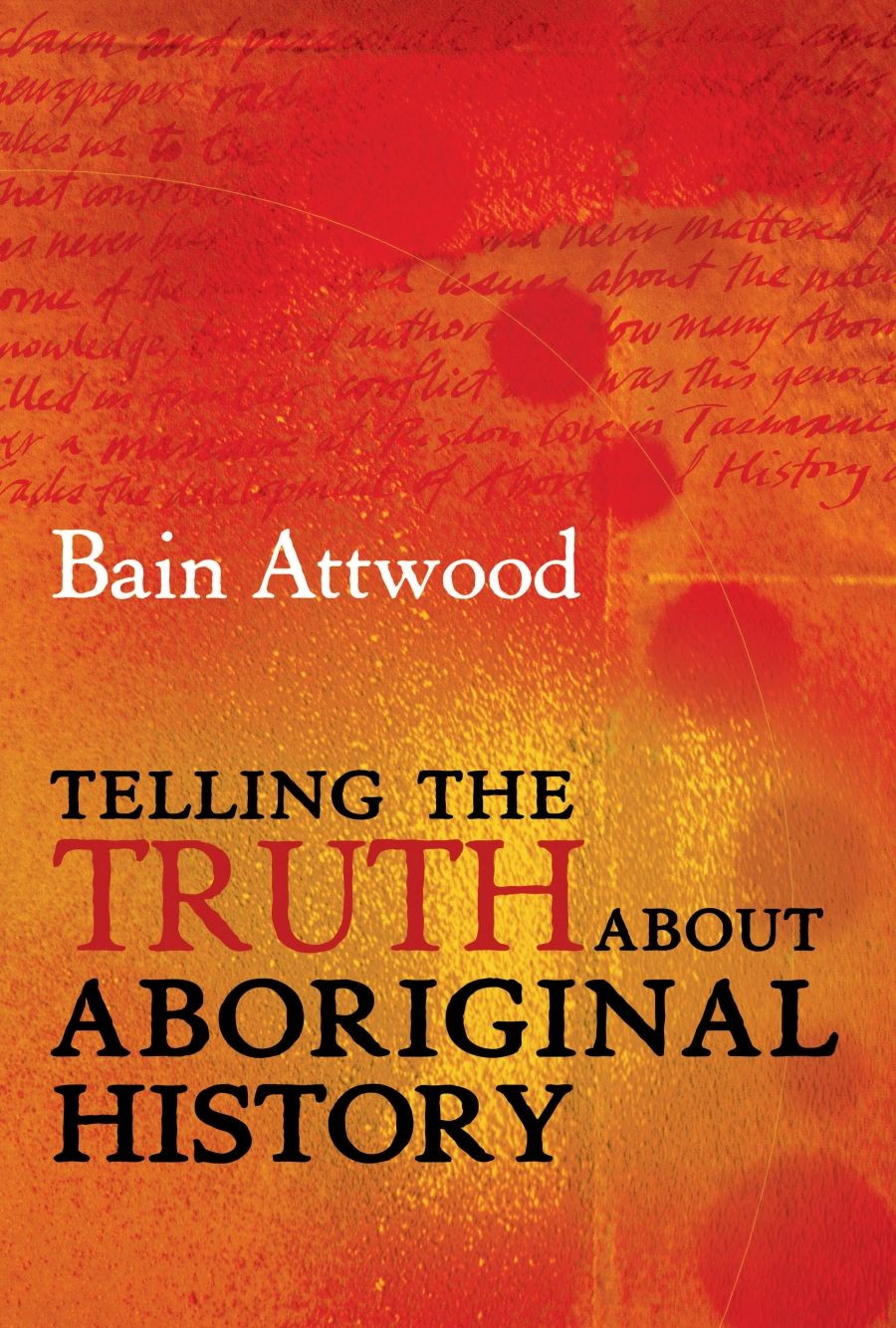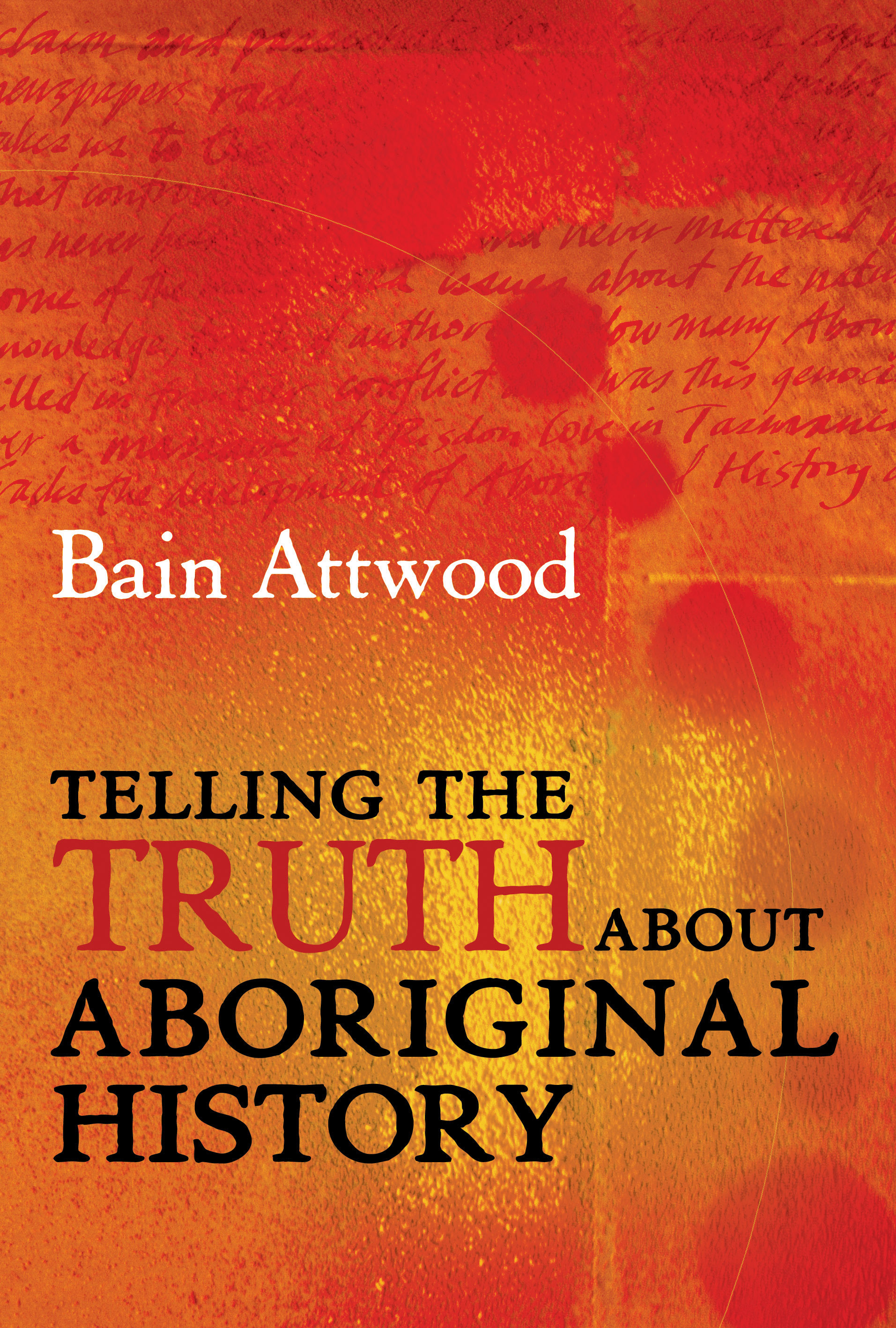
- Free Article: No
- Contents Category: Indigenous Studies
- Review Article: Yes
- Article Title: Provincialism
- Online Only: No
- Custom Highlight Text:
For the past twenty years, Bain Attwood has been trying to de-provincialise what he sees as an insular historiography of Aboriginal Australia by imploring colleagues to embrace the latest intellectual trends from France, America and New Zealand. In Telling the Truth about Aboriginal History, he expands on his many press articles on the ‘history wars’ and combines them with methodological reflection on postmodernism and post-colonialism. What advice does he have for his colleagues in the face of doubts cast on their work by newspaper columnists and other ‘history warriors’?
- Book 1 Title: Telling the Truth About Aboriginal History
- Book 1 Biblio: Allen & Unwin, $29.95 pb, 264 pp, 1741145775
- Book 1 Cover Small (400 x 600):

- Book 1 Cover (800 x 1200):

It is in the last section of the book on the public use of history and the rise of rival forms of historical knowledge, such as oral history and indigenous storytelling, that Attwood gets into his stride. Here his agenda is nothing less than ‘a basic reconceptualisation of historical practice and historical knowledge’ that can ‘transform the way we represent the work of history’. Why the need for such fundamental change? The field is methodologically provincial, he thinks. The empirical reconstructions of the frontier in the 1970s were based on a naïve realist view of the sources, such that Western protocols of verification – the use of settler-produced documents, above all – occluded indigenous experiences and thus prefigured a grossly incomplete account of frontier relations. Moreover, the positivism of mainstream Aboriginal historiography, like historiography generally, posits a distinction between past and present that ignores what Attwood, following Dominick LaCapra, calls the ‘implication’ of the historian in the past. Yet past and present cannot be separated so neatly, he insists, because we are dealing with ‘traumatic histories’, the effects of which linger in the present to colour memory and identity. Oral history and indigenous myths and legends thus pose a challenge to Western pretensions to objective knowledge of the past. The Captain Cook story common among Aborigines may be factually inaccurate, but it contains another kind of truth, namely the congealed indigenous experience of colonisation.
Attwood’s answer to the problem of rival truths – academic and indigenous – is to plead for tolerance. Historians should respect the esoteric truth that indigenous stories reveal while also becoming conscious of their own investments in the narratives they produce. Relying heavily on Dipesh Chakrabarty’s Provincializing Europe (2000), he hopes that the ensuing mutual regard will prevent the seamless integration of indigenous stories into a renewed master narrative of a redeemed, non-racist nation-state. A truly democratic public sphere will be characterised by dialogue between different memories of our past, and that is to the good. The truth about Aboriginal history, then, is that truth is protean, and that we need to live with this pluralism.
This section of the book, then, is a seemingly tolerant, if by now predictable, call to respect difference. Does the argument work? For all the criticism of historians’ blindness to their ‘implication’ in the past, Attwood does not thematise his own. The prose affects the tone of Olympian objectivity, implying distance from partisan histories, but the reader will not fail to notice, but may not understand the reasons for, the intemperate barbs directed at Robert Manne. The preoccupation with Windschuttle seems as excessive as the neglect of female historians in the field, such as Anna Haebich, Ann Curthoys, Marilyn Lake and Ann McGrath, is striking. Some reflexivity would have been welcome, too, in the decision to omit mention of Attwood’s extraordinary, patricidal attack on Henry Reynolds in History Compass (2004), in which, in a notably unguarded statement, Attwood described The Law of the Land (1987) as propagating a ‘lie’ about the origins of terra nullius. Like indigenous people, Reynolds, it seems, indulges in myth rather than scientific history, which, despite his postmodern rhetoric, Attwood remains determined to rescue. Nor is Attwood correct in the analysis generally. Historians have been well aware of the link between past and present in the work they do. Their ‘implication’ was explicit. An interest in indigenous people and contemporary racism in the 1960s and 1970s sent a generation of students such as Raymond Evans and Lyndall Ryan to the archives.
Attwood’s attack on the ‘naïve realism’ of the frontier conflict research agenda of the 1970s is also questionable. The problem was not documentary positivism but that he strove to replace the conflict paradigm with one stressing ‘accommodation’ between settlers and Aborigines, an approach embraced, incidentally, by Windschuttle. In this way, the empirical reconstruction of this now very contentious area was nipped in the bud. I can’t imagine this neglect occurring with the Armenian or any other genocide. Researchers in this field don’t let themselves be distracted by such methodological doubts.
The same can be said of Attwood’s curt dismissal of the connection between genocide and colonialism in Australia in view of the fact that historians around the world are writing about this relationship in North and South America, Asia and Africa. After all, by the nineteenth century, colonial authorities were well aware of the catastrophic demographic impact on indigenous peoples of European settlement, yet they pressed on regardless in the name of progress and civilisation. Attwood acknowledges that genocide is a term popular in indigenous circles, and is prepared to permit this view as allegorical – it is a ‘truthful myth’, like the Captain Cook story – but scholars are bidden to avoid it. Closer inspection reveals that, in fact, the indigenous understanding accords with international law and the conception of Raphael Lemkin (who coined the term in 1944) better than his own. For neither the UN definition of genocide nor that of Lemkin limits the perpetrator of the crime to the state. No grand plan need exist, nor even that mass killing take place. Some settler historians appear to be in thrall to myth rather more than is the case with indigenous people.
This example shows the limitations of hypostasising the categories of ‘indigenous’ and ‘academic/Western/European’ régimes of truth. Is our thinking really confined to ethnic categories? Indigenous people write academic history as well as tell traditional stories, just as settler Australians write poetry as well as rummage in archives. Everyone can make esoteric and exoteric knowledge. Rival claims, such as the genocide one, can be adjudicated exoterically. A democratic public sphere does not just, somewhat condescendingly, tolerate esoteric truths, but enables learning processes, which lends it a productively subversive potential. That is how the oppressive nature of colonialism was revealed to the world.
But the game of mutual recognition Attwood enjoins is inadequate for another reason. A priori, settler Australians have no reason to care about indigenous experiences. Even if they acknowledge Aboriginal suffering, they engage in the simple moral calculus called theodicy: any injustice committed has been redeemed by the just nature of the modern society that replaced indigenous ones. Now for settler Australians to criticise this theodicy, they need to be moved by stories of the suffering and to believe them to be true. Thus, it is not a problem, as Attwood contends, that readers identified with the Aborigines rather than the settlers in the frontier conflict books of the 1970s. In view of the long criminalisation of Aborigines in settler writing, it is an achievement. If historians are to promote moral consciousness among the public regarding the value of alterity, they need to master a certain rhetoric and emotional register, as Reynolds has, rather than engage in theoretical parlour games.
Telling the Truth about Aboriginal History is a missed opportunity to educate a wide readership about the nature and importance of empirical research. In its habitual invocation and lengthy, deferential quotation of (overwhelmingly male) ‘authorities’, and the deployment of vague yet seemingly profound statements that lay readers won’t understand, the book evinces a characteristically provincial combination of anxiety and overconfidence that does not answer the questions historians and the general public are asking about the research methods and the public use of history. This deprovincialisation of Aboriginal history needs to be de-provincialised.


Comments powered by CComment